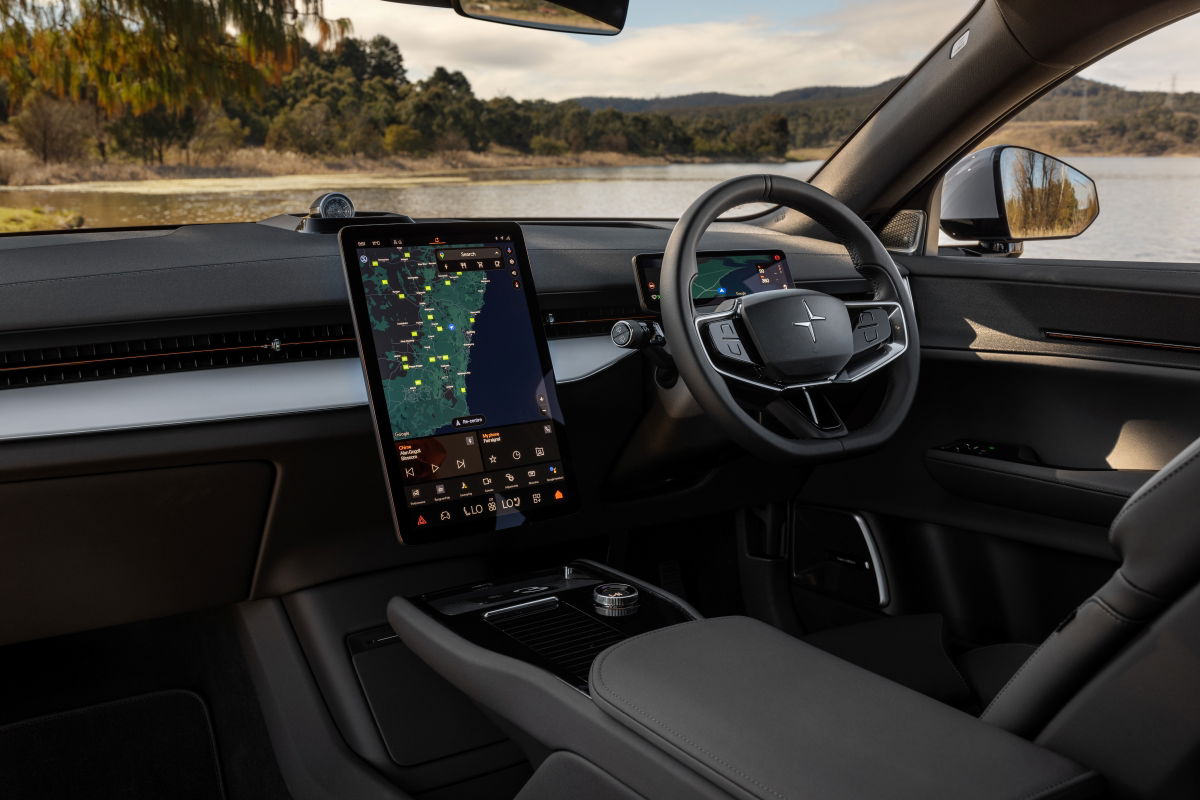
Polestar will be a familiar name to Supercars fans, but sound unfamiliar to anyone who doesn’t remember Scott McLaughlin’s coming-of-age in the bright blue Volvo S60 built by the former Swedish performance and racing division.
While it started out as Volvo’s high-performance skunkworks, it is now a very different entity entirely. It’s still connected to Volvo, as both brands are now under the control of Chinese auto giant Geely, but has evolved to become its own standalone brand.
Polestar is now an all-electric car company in its own right, with a clear focus on design, performance and sustainability. Those seemingly counterintuitive priorities are highlighted with labels on the outside telling you how much power it makes and on the inside with a note on the seats telling you what recycled materials they trim is made of.
READ MORE: Review – Polestar 2 flips the script
The Polestar 1 was actually a hybrid coupe that never made it to Australia, while the Polestar 2 is a small sedan designed to directly rival the Tesla Model 3 and has been on sale for several years already. While sales have fluctuated it has laid the foundations for a potentially exciting future, with the Polestar 3 SUV set to be followed by the Polestar 4 coupe-style SUV and then the Polestar 5 sports sedan (have you cracked the code on the company’s name structure?) all within the next 18 months. These will give the brand challengers to the likes of the new electric Porsche Macan, BMW iX, Audi Q8 e-tron (in the case of the 3 and 4 models) and the established Porsche Taycan as well as the Audi e-tron GT and Lotus Emeya (for the Polestar 5).

For now, though, our attention is firmly on the Polestar 3, as we were invited to sample it on Australian roads for the first time. It says a lot about a company’s faith in its product where they decide to launch it, twisty and winding roads indicates they have faith in its handling, whereas long freeway stretches suggest they don’t want you thinking too much about its driving prowess.
Polestar chose Tasmania – the tiny island filled to the brim with Australia’s best driving roads – which should tell you about how much faith the brand has in the performance and handling of the PS3 (as I’ll call it for brevity).
READ MORE: How Polestar plans to take on Porsche and Tesla
At 4.9m long, and with a 2.9m wheelbase, the PS3 is not a small SUV and has space for four adults in comfort (we tried fitting five and while possible it is a squeeze). But Polestar was adamant that this is a car that can handle itself when the going gets twisty.
That’s in part because the Polestar 3 Performance variant has torque vectoring with a dual clutch set-up (that uses the clutches to adjust wheel speed rather than pinching the brakes), as well as adaptive air suspension with active dampers, Brembo brakes, staggered wheels and bespoke tyres. As a result, despite its size and weight (batteries aren’t light) the PS3 acquitted itself remarkably well across roads that were previously used in Targa Tasmania.

Make no mistake, I’m not suggesting the PS3 will give a Porsche 911 a run for its money, but for a family friendly SUV it feels responsive and powerful. It helps that its dual-motor powertrain produces a very healthy 380kW of power and 910Nm of torque, so it has the ability to launch out of corners with ferocity.
It also has respectable range (at least on paper) with the Long Range Dual Motor managing a claimed 628km and the Performance Pack version still managing up to 561km. Certainly on our speedy and open-road trip those numbers didn’t feel achievable, but around town (with more regenerative braking) and a lighter right foot it may be possible. Even so, we managed to take the scenic route from Launcenston to Hobart with only one top-up charge.
But the driving dynamics are only part of the story. From its inception, Polestar has been a brand centred around design and sustainability, as it knew that as electric vehicles became increasingly similar from a powertrain perspective (quick and quiet) it needed something unique to stand out.
That’s why Polestar has a Swedish design studio (alongside Volvo) that works to create vehicles that look special, different and don’t fall into the EV trend of becoming a ‘blob on wheels’ in the search of the most aerodynamic shape. The PS3 is very slippery through the air but also looks distinctive thanks to a trade-off between the designers and aerodynamicists. The key is the ‘aero bridge’ that sits at the front of the bonnet, which helps to channel air where it’s needed and also allows for a lower frontal area.

This design effort carries over to the interior, with a clear Scandinavian minimalist aesthetic, which includes the aforementioned seat labels as well as a bespoke infotainment system with carefully designed graphics.
The technology can be overwhelming at times, with small details like the steering column and mirror adjustment all done via the central touchscreen rather than physical buttons. The same is true of the multitude of drivetrain settings, but once you get used to the navigation, it becomes second nature – even if it could be easier with some buttons and/or dials.
Ultimately, the Polestar 3 will be a niche offering, given the range starts at $132,900 for the Long Range and $141,900 for the Long Range with Performance Pack. A cheaper, single motor variant will be added soon, along with the 2025 model year but for now the launch edition is available to order.
For anyone looking for an electric SUV with some serious performance and unique design, with some serious consideration to sustainability thrown in for good measure, the Polestar 3 is well worth considering.
It may not be a famous name just yet, but as McLaughlin demonstrated, Polestar can help launch you into a bright future.












Discussion about this post